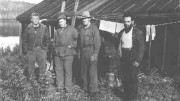In the late 1980s, veteran northern Saskatchewan bush pilot Bill MacNeill turned resource developer.
MacNeill planned to develop a gold property at Laonil Lake, about 135 km northeast of La Ronge in northern Saskatchewan. The property wasn’t a new one. In fact, mining giant Consolidated Mining and Smelting discovered it 50 years earlier. It had never been developed, partly because of its isolation and high costs.
But MacNeill knew that the north was changing, and had an insight into how the mine could be developed. He acquired the property and got his company Claude Resources to undertake the development.
It was the fall of 1990, and for many new mines, money was tight and the project had to get into operation quickly if investors were to be kept involved. Claude Resources applied for government permits well in advance of when it needed access to the site, but the government officials slow-walked the application for two reasons: they believed there were insufficient gold resources to justify the project, and they knew the government would change in the next election.
MacNeill was desperate to get concrete footings poured before the fall freeze-up so winter construction could continue on the mill. Otherwise he would lose a whole year of production, and likely his investors.
I advised MacNeill to continue with the footings without a permit. He did, and within a few weeks the footings were almost complete when the government people threatened to charge him with various offences. I advised him to ignore their threats, since if they ever got into court, they would have to explain to a judge why they had slow-walked the project and missed so many of their own promised deadlines — something that would be embarrassing for the officials involved.
In the end, accommodations were made and mine construction proceeded, with the first gold doré bar poured in 1991.
Fast-forward to this past summer, and that little mine has produced over 1 million oz. gold (at today’s price of US$1,700 per oz., this is equal to US$1.7 billion), employs almost 400 people and has sufficient gold reserves to operate another 20 years. Today, that not-so-little mine has become an economic and employment anchor in the region, and has never had a serious environmental problem in the past 20 years. But if the officials had had their way — it never would have been built!
— Walter Keyes was deputy minister of Northern Saskatchewan from 1985 to 1990, and was involved with many new projects during that period. He believes that today’s environmental processes, in his words, are “simply social engineering projects with little benefit to the environment, and cause great harm to the economy and society.”


Be the first to comment on "Odds ‘n’ sods: Seabee, The little mine that beat the odds"